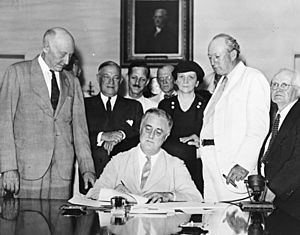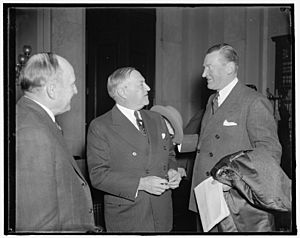Robert F. Wagner facts for kids
Quick facts for kids
Robert F. Wagner
|
|
|---|---|

Harris & Ewing photo, Library of Congress
|
|
| United States Senator from New York |
|
| In office March 4, 1927 – June 28, 1949 |
|
| Preceded by | James W. Wadsworth Jr. |
| Succeeded by | John Foster Dulles |
| Acting Lieutenant Governor of New York | |
| In office October 17, 1913 – December 31, 1914 |
|
| Governor | Martin H. Glynn |
| Preceded by | Martin H. Glynn |
| Succeeded by | Edward Schoeneck |
| Member of the New York Senate from the 16th district |
|
| In office January 1, 1909 – December 31, 1918 |
|
| Preceded by | John T. McCall |
| Succeeded by | James A. Foley |
| Member of the New York State Assembly |
|
| In office January 1, 1905 – December 31, 1905 |
|
| Preceded by | Gotthardt A. Litthauer |
| Succeeded by | Maurice F. Smith |
| Constituency | 30th New York district |
| In office January 1, 1907 – December 31, 1908 |
|
| Preceded by | Thomas Rock |
| Succeeded by | George W. Baumann |
| Constituency | 22nd New York district |
| Personal details | |
| Born |
Robert Ferdinand Wagner
June 8, 1877 Nastätten, Hesse-Nassau, Kingdom of Prussia, German Empire |
| Died | May 4, 1953 (aged 75) New York City, U.S. |
| Political party | Democratic |
| Spouse |
Margaret Marie McTague
(m. 1908; died 1919) |
| Children | Robert Ferdinand Wagner II |
| Alma mater |
|
| Profession | Lawyer |
Robert Ferdinand Wagner I (June 8, 1877 – May 4, 1953) was an important American politician. He was a Democratic U.S. Senator from New York. He served in the Senate from 1927 to 1949.
Wagner was born in Prussia, which is now part of Germany. His family moved to the United States in 1885. After studying law, Wagner became involved in New York politics. He was elected to the New York State Legislature. He later became a leader in the state senate.
He worked closely with Al Smith, another New York City Democrat. They focused on reforms to help working-class people. They built a group of supporters including unions and social workers. This group helped pass many new laws. Wagner left the state senate in 1918. He then served as a judge before being elected to the U.S. Senate in 1926.
As a Senator, Wagner was a key figure in the New Deal Coalition. He strongly supported the labor movement. He was a close friend and supporter of President Franklin D. Roosevelt. He helped create three major laws: the National Labor Relations Act of 1935, the Social Security Act of 1935, and the Housing Act of 1937. Wagner retired from the Senate in 1949 due to poor health. He passed away in 1953. His son, Robert F. Wagner Jr., later became the mayor of New York City.
Contents
Robert F. Wagner: Early Life and Education
Robert F. Wagner was born on June 8, 1877. His birthplace was Nastätten, in what was then the Kingdom of Prussia. Today, this area is part of Germany. In 1885, when he was eight years old, his family moved to the United States.
They settled in the Yorkville neighborhood of New York City. Wagner went to public schools there. His father worked as a janitor.
Wagner attended the City College of New York. He graduated from there in 1898. He then studied law at New York Law School. He became a lawyer in 1900. He was raised as a Lutheran. Later, he became a Methodist and taught Sunday school. In 1946, he converted to Roman Catholicism.
Robert F. Wagner's Political Start
As a young lawyer, Wagner joined the Tammany Hall Democratic group in Manhattan. This group was a powerful political organization. He was elected to the New York State Assembly in 1905. He served there again in 1907 and 1908.
Serving in the New York State Senate
Wagner became a member of the New York State Senate in 1909. He served there until 1918. From 1911 to 1914, he was the President pro tempore of the State Senate. This meant he was the leader of the Senate.
He became the Acting Lieutenant Governor of New York for a short time. This happened after Governor William Sulzer was impeached. The Lieutenant Governor, Martin H. Glynn, then became Governor.
Helping Workers After the Triangle Fire
After the terrible Triangle Shirtwaist Factory fire in 1911, Wagner became very active. He led the State Factory Investigating Committee. His friend, Al Smith, was the Vice Chairman. They held many public investigations across New York. They interviewed many people and gathered a lot of information.
Their work started by looking into fire safety. But they soon looked at other dangers in factories. Their findings led to 38 new laws in New York State. These laws helped protect workers. This work made Wagner and Smith known as important reformers. They helped improve the lives of working-class people.
Wagner also took part in the New York State Constitutional Conventions in 1915 and 1938. He served as a judge on the New York Supreme Court from 1919 to 1926.
Robert F. Wagner: U.S. Senator and New Deal Leader

In 1926, Wagner was elected as a Democrat to the United States Senate. He was re-elected three more times. He served until June 28, 1949. He resigned because of poor health. He was unable to attend Senate sessions from 1947 to 1949 due to a heart problem.
Wagner was a delegate to the United Nations Monetary and Financial Conference in 1944. This important meeting helped create new international financial systems.
Working with President Roosevelt
Wagner knew Franklin D. Roosevelt from their time in the New York state legislature. He became part of Roosevelt's "Brain Trust." This was a group of advisors who helped create the New Deal. Wagner was very involved in issues related to labor. He fought for legal protection and rights for workers. He was a key leader in shaping the New Deal programs.
A British scholar named Isaiah Berlin described Wagner in 1943. He called Wagner a "veteran Liberal" and a "devotee of the New Deal." He said Wagner was the "Greatest champion of the Liberal cause in the United States Senate" at that time. Wagner supported all of President Roosevelt's plans.
Major Laws and Achievements
Wagner helped create many important laws. These include the National Industrial Recovery Act in 1933. He also helped pass the Wagner–Steagall Housing Act of 1937.
When the Supreme Court declared parts of the National Industrial Recovery Act unconstitutional, Wagner acted quickly. He helped pass the National Labor Relations Act in 1935. This law is also known as the Wagner Act. It was a huge step for organized labor in the United States.
The National Labor Relations Act created the National Labor Relations Board. This board helps solve problems between unions and companies. It greatly expanded workers' rights. It banned many "unfair labor practices." It also guaranteed all workers the right to form a union. This law is one of Wagner's greatest achievements.
Wagner was also very important in writing the Social Security Act. He first introduced this bill in the Senate. This act created a system of social insurance. It provides benefits for retired workers, the unemployed, and others.
He also introduced the Railway Pension Law. He co-sponsored the Wagner–O'Day Act. This law helps people who are blind or have severe disabilities find work.
Efforts for Civil Rights and Refugees
In 1934, Wagner and Edward P. Costigan sponsored a federal anti-lynching law. They tried to get President Roosevelt to support it. However, Roosevelt worried about losing support from Southern Democrats. Even without the law, the threat of federal action helped reduce lynchings.
In 1939, Wagner worked with Representative Edith Nourse Rogers. They proposed the Wagner–Rogers Bill. This bill aimed to allow 20,000 Jewish children under 14 to come to the U.S. from Nazi Germany. Sadly, the bill did not pass.
On June 28, 1949, Wagner resigned from the Senate due to his health. John Foster Dulles was appointed to fill his seat temporarily.
Robert F. Wagner: Personal Life and Legacy
In 1908, Robert Wagner married Margaret Marie McTague. She passed away in 1919. They had one son together.
In 1927, his hometown of Nastätten gave him its first honorary citizenship. In 1961, his son, Robert Wagner Jr., also received this honor.
Wagner passed away on May 4, 1953, in New York City. He was buried in Calvary Cemetery, Queens.
Family and Honors
His son, Robert F. Wagner Jr., followed in his footsteps. He served as Mayor of New York City from 1954 to 1965. His grandson, Robert Ferdinand Wagner III, also held important public roles in New York City.
On September 14, 2004, a portrait of Robert F. Wagner was put on display. It joined other famous senators in the Senate Reception Room. These senators are known for their important contributions.
A public middle school in New York City is named after him. It is called Robert F. Wagner Middle School. Also, a building at the City College of New York was named Wagner Hall in his honor.
See also
Template:Kids robot.svg In Spanish: Robert F. Wagner para niños
- United States labor law
- Social Security (United States)
- Public housing in the United States
- List of United States senators born outside the United States


